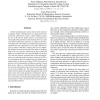Free Online Productivity Tools
i2Speak
i2Symbol
i2OCR
iTex2Img
iWeb2Print
iWeb2Shot
i2Type
iPdf2Split
iPdf2Merge
i2Bopomofo
i2Arabic
i2Style
i2Image
i2PDF
iLatex2Rtf
Sci2ools
135
click to vote
MASCOTS
2004
2004
An Optimisation Model for a Two-Node Router Network
Architectural designs for routers and networks of routers to support mobile communication are analysed for their end-to-end performance using a simple Markov model. In view of the diverse design options, such models have many adjustable parameters and choosing the best set for a particular performance objective is a delicate and timeconsuming task. We introduce an optimisation approach to automate this task, illustrated in a two-node, tandem network of routers with finite capacity and recovery buffers. We minimise the mean end-to-end delay subject to an upper limit on the rate of losses, which may be due to either full buffers or corrupted data. Losses at a full buffer are inferred by a time-out whereas corrupted data is detected immediately on receipt of a packet at a router, causing a N-ACK to be sent upstream. Recovery buffers hold successfully transmitted packets so that on receiving a N-ACK, the packet, if present, can be retransmitted, avoiding an expensive resend from source. H...
| Added | 31 Oct 2010 |
| Updated | 31 Oct 2010 |
| Type | Conference |
| Year | 2004 |
| Where | MASCOTS |
| Authors | Nalan Gülpinar, Peter G. Harrison, Berç Rustem, Louis-François Pau |
Comments (0)

